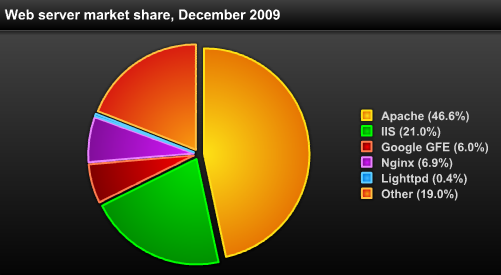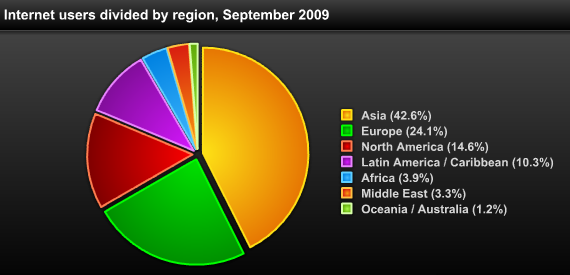Internet 2009 in facts and figures
 Once, at school, a 42 MB hard drive seemed huge to me. Now it's 2010, and you won't surprise anyone with the optical Internet at home with a 100 megabit channel or $ 49 for the monthly rent of a dedicated server. Progress does not stand still, let us look at the figures, how the Network has changed over the past 2009y year.
Once, at school, a 42 MB hard drive seemed huge to me. Now it's 2010, and you won't surprise anyone with the optical Internet at home with a 100 megabit channel or $ 49 for the monthly rent of a dedicated server. Progress does not stand still, let us look at the figures, how the Network has changed over the past 2009y year.The picture described under habrakat was obtained after analyzing the latest reports of Pingdom , Domain IP History and NetCraft .
So,
Post office:
Over the year, over 90 trillion e-mails were sent, which is approximately 247 million letters per day. All this traffic was generated by almost one and a half billion email users worldwide.
I think no one will see the percentage of spam in this volume of mail - 81 %, which is 24 % more than in the year 2008. Well, I hope that the volume of spam will not exceed the 100% mark;)
Users:
The total number of network users: 1.73 billion. I note that Wikipedia claims that in 2009 the world's population was approximately 6.832 billion people. Thus, every 4th inhabitant of the planet uses the Internet, and every sixth inhabitant of the planet is hungry ...
Total, the year 2009 gave the network 18 % of new users.
But what surprises me:

738,257,230 - the number of users from Asia,
418,029,796 - Europeans and only
252,908,000 - from North America (see, what kind of round numbers counted).
Latin America and the Caribbean grabbed a piece of 179,031,479 users, and Africa - "only"
67,371,700 people.
Sites / domains:
There are 234 million domains on the Internet (including subdomains), which is 47 million more than it was a year ago.
The total number of domains ( in the first level zones ) is 187 million and they are located on almost 5 million ( 4.856.909 ) different IP addresses.
That is, for each ip address there are a little more than 38 domains :)
The latter fact is not entirely correct, because out of 187 million, only 131 million domains have IP (to be more precise - every 5th registered domain is not used for content placement and A records are not registered in the DNS). With this amendment, each IP address, on average, carries 27 different websites.
Hosting:
The leader among hosting companies was GoDaddy with a list of more than 20 million (!) Sites. It is also the fastest growing company. For example, in the last month alone, GoDaddy has sheltered over 170,000 new sites in its network.
I must say that I personally have only a negative experience with this company, but this is a topic for another note.
Another interesting observation was that the 68.X.X.X network is currently the most densely populated on the Internet, with more than 15 million sites.
Another observation in itself emerged from the data analysis of site languages . So, it turns out that 72.2 % of sites on the network are English-speaking, Chinese-speaking only 5.7 %, and 3.4 % of the websites are Spanish-speaking. The penultimate fact sincerely surprised me. The number of users does not always turn into quality?
Web server:
The distribution pattern of the server software is well represented in the diagram at the beginning of the topic.
I will add it with figures on the growth and decline of market share (information was taken from pingdom -a):
13.9% - growth in the share of Apache in 2009.
-22.1% - increase in the share of IIS in 2009.
35.0% - growth in the share of Google GFE in 2009.
384.4% - increase in the share of Nginx in 2009.
-72.4% - Lighttpd share growth in 2009.
Note nginx-jerk to which I myself translated everything that is possible;)
By the way, does anyone have a hypothesis, why did Lighttpd lose so much?
Social networks and blogs:
I’ll finish this statistical slice with data on blogs and other "social media":
Currently, the number of blogs on the Web is 126 million.
84 % of all social networks, among their users, have more women than men (this really confused me).
Twitter every day gives us 27.3 million meaningless short messages. Forgive me Twitter fans, I sometimes use it myself;) By the way, more than half of Twitter.com users are located in the USA.
And the last fact - the number of applications for Facebook has exceeded 500 (!) Thousand.
')
Interestingly, what particularly surprised you, dear% username%, in this stream of water and meaningless numbers? ;)
Source: https://habr.com/ru/post/81787/
All Articles